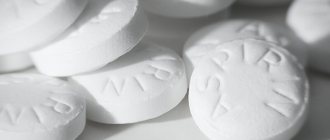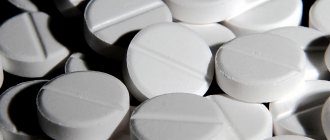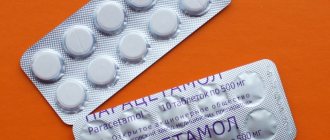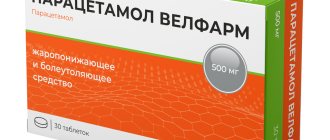Overdose
Liver damage is possible in adults who took 10 g or more of paracetamol, and in children who took more than 150 mg/kg body weight. In patients with risk factors (long-term use of carbamazepine, phenobarbital, phenytoin, primidone, rifampicin, St. John's wort or other drugs that induce liver enzymes, alcohol abuse, glutathione system deficiency, for example: digestive disorders, cystic fibrosis, HIV infection, fasting, cystic fibrosis, cachexia ) Taking 5g or more of paracetamol may cause liver damage.
Paracetamol Soluble effervescent tablets 500 mg N12
Compound
active ingredient
: paracetamol;
1 tablet contains paracetamol 500 mg;
Excipients
: sodium bicarbonate, sodium carbonate, citric acid, sorbitol (E420), sodium saccharin, povidone, sodium lauryl sulfate, dimethicone.
Dosage form
Effervescent tablets.
Basic physical and chemical properties
: tablets are white, round, flat, with beveled edges and a notch on one side. When dissolved in water, the release of gas bubbles is observed.
Pharmacotherapeutic group
Analgesics and antipyretics. Paracetamol.
ATX code N02B E01.
Pharmacodynamics
The drug contains paracetamol, an analgesic and antipyretic (pain reliever and antipyretic). The effect is based on the suppression of prostaglandin synthesis in the central nervous system.
Pharmacokinetics
Paracetamol is quickly and almost completely absorbed from the gastrointestinal tract and distributed in most tissues of the body. The binding of paracetamol to plasma proteins is minimal when taken in therapeutic doses.
As a result of clinical studies, it was shown that the maximum concentration of paracetamol in the blood plasma when taking the drug is achieved after 20 minutes, which significantly exceeds the value for conventional tablets containing paracetamol.
Paracetamol is metabolized in the liver and excreted in the urine as conversion products. The half-life after oral administration is approximately 2.3 hours.
Indications
Treatment of pain and fever, in particular headaches, including migraines and tension headaches, back pain, rheumatic pain, osteoarthritis pain, muscle pain, sore throat, periodic pain in women, neuralgia, toothache, post-excision pain tooth or dental procedures, fever and pain after vaccination, cold and flu symptoms such as fever, aches, pain.
Contraindications
Hypersensitivity to the components of the drug, severe liver and/or kidney dysfunction, congenital hyperbilirubinemia, glucose-6-phosphate dehydrogenase deficiency, alcoholism, blood diseases, Gilbert's syndrome, severe anemia, leukopenia. Age up to 6 years.
Interaction with other drugs and other types of interactions
The rate of absorption of paracetamol may be increased by the use of metoclopramide and domperidone and decreased by the use of cholestyramine. The anticoagulant effect of warfarin and other coumarins, with an increased risk of bleeding, may be enhanced by concomitant long-term use of paracetamol. Periodic use does not have a significant effect. Barbiturates reduce the antipyretic effect of paracetamol.
Anticonvulsants (including phenytoin, barbiturates, carbamazepine), which stimulate the activity of microsomal liver enzymes, may increase the toxic effects of paracetamol on the liver due to an increase in the degree of conversion of the drug to hepatotoxic metabolites. With the simultaneous use of paracetamol with hepatotoxic drugs, the toxic effect of the drugs on the liver increases. The simultaneous use of high doses of paracetamol with isoniazid increases the risk of developing hepatotoxic syndrome.
Paracetamol reduces the effectiveness of diuretics. Do not use simultaneously with alcohol.
Features of application
The drug contains paracetamol, therefore the drug should not be used together with other drugs containing paracetamol and used, for example, to reduce fever, treat pain, symptoms of flu and colds or insomnia. Concomitant use with other drugs containing paracetamol may lead to an overdose. An overdose of paracetamol can cause liver failure, which may lead to liver transplantation or death.
If you have liver or kidney diseases, you should consult your doctor before using the drug.
It should be taken into account that in patients with liver disease, the risk of hepatotoxic action of paracetamol increases; the drug may affect the results of laboratory tests on the levels of glucose and uric acid in the blood. Patients taking analgesics every day for mild arthritis should consult a doctor before use.
Cases of liver dysfunction/liver failure have been documented in patients who had low glutathione levels, for example, with severe malnutrition, anorexia, low body mass index or chronic alcoholism.
In patients with decreased glutathione levels, for example in severe infections such as sepsis, the risk of metabolic acidosis increases when taking paracetamol. Symptoms of metabolic acidosis include deep, rapid or labored breathing, nausea, vomiting, and loss of appetite. You should consult a doctor immediately if these symptoms occur.
If symptoms do not go away, you should consult a doctor.
1 tablet contains 427 mg sodium (854 mg sodium per two tablets), which should be taken into account in patients on a sodium-controlled diet. 1 tablet contains 59.9 mg of sorbitol (E 420). If the patient has an intolerance to certain sugars, a doctor should be consulted before taking this drug.
Keep the drug out of sight of children and out of the reach of children.
The ability to influence reaction speed when driving a vehicle or operating machinery
Does not affect.
Use during pregnancy or breastfeeding
Paracetamol crosses the placental barrier and passes into breast milk.
Prescription of the drug during pregnancy and lactation is possible if the expected benefit to the mother outweighs the potential risk to the fetus or child. Studies in humans and animals have not revealed any risk to fetal development, pregnancy or breastfeeding. A large body of data in pregnant women does not indicate either malformative or feto/neonatal toxicity. Epidemiological studies of neurodevelopment in children exposed in utero to paracetamol are inconclusive. If clinically necessary, paracetamol can be used during pregnancy, but it should be used at a low effective dose for the shortest time and with the least frequency possible.
Directions for use and doses
The drug is intended for oral administration.
Do not exceed the recommended dose. The lowest dose of the drug necessary to obtain a therapeutic effect should be used.
Adults and children over 12 years old
: Dissolve 1-2 tablets in half a glass of water, take every 4-6 hours if necessary. The interval between doses should be at least 4 hours. The maximum daily dose is no more than 8 tablets within 24 hours.
The interval between doses is at least 4 hours.
Do not take more than 8 tablets (4000 mg) within 24 hours.
Children (ages 6-11 years)
: Dissolve ½-1 tablet in half a glass of water. Take every 4-6 hours as needed.
A single dose of paracetamol is 10 - 15 mg/kg body weight, the maximum daily dose is 60 mg/kg body weight.
The maximum period of use for children without consulting a doctor is 3 days.
Do not take more than 4 doses in 24 hours.
The interval between doses is at least 4 hours.
Children
Not recommended for use in children under 6 years of age.
Overdose
An overdose of paracetamol can cause liver failure, which may lead to liver transplantation or death. Liver damage is possible in adults who took 10 g or more of paracetamol, and in children who took more than 150 mg/kg body weight. In patients with risk factors (long-term treatment with carbamazepine, phenobarbital, phenytoin, primidone, rifampicin, St. John's wort or other drugs that induce liver enzymes; regular intake of excess amounts of ethanol; glutathione cachexia (digestive disorders, cystic fibrosis, HIV infection, hunger, cachexia) ) Taking 5g or more of paracetamol may cause liver damage.
In case of overdose, emergency medical care is required. Treatment should be started immediately. The patient should be taken to hospital even if there are no early symptoms of overdose.
Symptoms of overdose in the first 24 hours
: pallor, nausea, vomiting, loss of appetite and abdominal pain. Liver damage may appear 12-48 hours after an overdose. Impaired glucose metabolism and metabolic acidosis may occur. In severe poisoning, liver failure can progress to encephalopathy, hemorrhage, hypoglycemia, coma and death. Acute renal failure with acute tubular necrosis can manifest as severe lumbar pain, hematuria, proteinuria and develop even in the absence of severe liver damage. Cardiac arrhythmia and acute pancreatitis have also been observed, usually accompanied by liver dysfunction and hepatotoxicity.
With long-term use of the drug in large doses, the hematopoietic organs may develop aplastic anemia, pancytopenia, agranulocytosis, neutropenia, leukopenia, thrombocytopenia. When taking large doses, the central nervous system may experience dizziness, psychomotor agitation, and disorientation; from the urinary system - nephrotoxicity (renal colic, interstitial nephritis, capillary necrosis).
Symptoms may be limited to nausea and vomiting or may not reflect the severity of overdose or the risk of organ damage. Treatment with activated charcoal should be considered if an excessive dose of paracetamol has been taken within 1 hour. Plasma concentrations of paracetamol should be measured 4 hours or later after administration (earlier concentrations are unreliable). Treatment N-acetylcysteine can be applied within 24 hours after taking paracetamol, but the maximum protective effect occurs when it is used within 8 hours after administration. The effectiveness of the antidote decreases sharply after this time. If necessary, the patient should be administered N-acetylcysteine intravenously according to current recommendations. In the absence of vomiting, oral methionine can be used as an appropriate alternative in remote areas outside the hospital.
High doses of sodium bicarbonate may cause gastrointestinal symptoms such as belching and nausea. In addition, high doses of sodium bicarbonate may cause hypernatremia; therefore, electrolyte levels must be monitored and the patient provided appropriate support.
Adverse reactions
From the blood and lymphatic system
: (rare <1/10000) - thrombocytopenia.
From the immune system
: (rare <1/10000) - anaphylaxis, skin hypersensitivity reactions including skin rash, angioedema, Stevens-Johnson syndrome and toxic epidermal necrolysis.
From the respiratory system, chest and mediastinum
: (rare <1/10000) - bronchospasm in patients sensitive to acetylsalicylic acid and other NSAIDs.
From the digestive system
: (rare <1/10000) - liver dysfunction.
Also, after taking drugs containing paracetamol, the following adverse reactions are possible: skin itching, erythema multiforme, nausea, epigastric pain; hypoglycemia, up to hypoglycemic coma; agranulocytosis, anemia, sulfhemoglobinemia and methemoglobinemia (cyanosis, shortness of breath, heart pain) hemolytic anemia, bruising or bleeding, increased activity of liver enzymes, usually without the development of jaundice.
Best before date
2 years.
Storage conditions
Store in original packaging at a temperature not exceeding 25 °C.
Keep out of the reach of children.
Package
Effervescent tablets No. 12 (2×6) in a strip in a box.
Vacation category
Over the counter
Manufacturer
Limited Liability Company "Pharmaceutical.
Manufacturer's location and address of place of business
Ukraine, 61013, Kharkov region, Kharkov city, Shevchenko street, building 22.
© Translation into Russian by the editorial team of apteka24.ua.
Source: “State register of medicinal facilities of Ukraine”, 2020.
Side effects
From the blood and lymphatic system: (rare <1/10000) - thrombocytopenia.
From the immune system: (rare <1/10000) - anaphylaxis, hypersensitivity reactions on the skin, including skin rash, angioedema, Stevens-Johnson syndrome and toxic epidermal necrolysis.
From the respiratory system, chest and mediastinum: (rare <1/10000) - bronchospasm in patients sensitive to acetylsalicylic acid and other NSAIDs.
From the digestive system: (rare <1/10000) - liver dysfunction.
Also, after taking medications containing paracetamol, the following adverse reactions are possible: skin itching, exudative erythema multiforme, nausea, epigastric pain; hypoglycemia, up to hypoglycemic coma; agranulocytosis anemia sulfhemoglobinemia and methemoglobinemia (cyanosis, shortness of breath, heart pain) hemolytic anemia bruising or bleeding increased activity of liver enzymes, usually without the development of jaundice.
Paracetamol for pain and fever effervescent tablets 500 mg 12 pcs
Pharmacological group:
Analgesic non-narcotic drug ATC code: N02BE01
Pharmacodynamics:
Paracetamol (para-aminophenol derivative) has an analgesic, antipyretic and weak anti-inflammatory effect.
The exact mechanism of the analgesic and antipyretic effect of paracetamol has not been established. Apparently, it includes central and peripheral components. The drug blocks cyclooxygenase I and II mainly in the central nervous system, affecting the centers of pain and thermoregulation. In inflamed tissues, cellular peroxidases neutralize the effect of paracetamol on cyclooxygenase, which explains its almost complete lack of anti-inflammatory effect.
The drug does not have a negative effect on water-salt metabolism (sodium and water retention) and the mucous membrane of the gastrointestinal tract due to the lack of influence on the synthesis of prostaglandins in peripheral tissues.
Pharmacokinetics:
Absorption After oral administration, paracetamol is absorbed quickly and completely. Cmax (maximum concentration in blood plasma) is achieved 10-60 minutes after administration.
Distribution Paracetamol is rapidly distributed in all tissues. The concentration in blood, saliva and plasma is the same. Plasma protein binding is negligible.
Metabolism Paracetamol is mainly metabolized in the liver. There are two main metabolic pathways producing glucuronides and sulfates. The latter is mainly used if the dose of paracetamol exceeds the therapeutic dose. A small amount of paracetamol is metabolized by the cytochrome P450 isoenzyme to form the N-acetylbenzoquinoneimine intermediate, which under normal conditions is rapidly detoxified by glutathione and excreted in the urine after binding to cysteine and mercaptopuric acid. However, with massive intoxication, the content of this toxic metabolite increases.
Excretion is carried out mainly through urine. 90% of the dose of paracetamol taken is excreted by the kidneys within 24 hours, mainly in the form of glucuronide (60 to 80%) and sulfate (20 to 30%). Less than 5% is excreted unchanged. The half-life is approximately 2 hours. In case of severe renal dysfunction (creatinine clearance less than 30 ml/min), the elimination of paracetamol and its metabolites is delayed.
Note!
Description of the drug Paracetamol Soluble table. thorn. 500 mg No. 12 on this page is a simplified author’s version of the apteka911 website, created on the basis of the instructions for use.
Before purchasing or using the drug, you should consult your doctor and read the manufacturer's original instructions (attached to each package of the drug). Information about the drug is provided for informational purposes only and should not be used as a guide to self-medication. Only a doctor can decide to prescribe the drug, as well as determine the dose and methods of its use.






